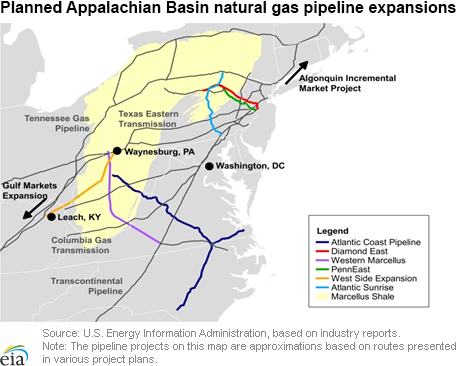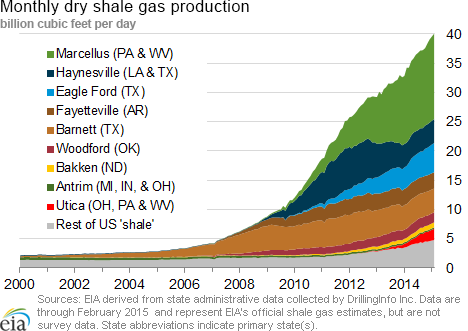In the News:
Appalachian Basin infrastructure growth will make Marcellus/Utica gas available to broader market
Dry natural gas production for the Lower 48 states hit record levels this winter and has averaged 72 billion cubic feet per day (Bcf/d) so far in March, with production from shale plays, or regions, accounting for more than 50% of the total. The Appalachian Basin, with production centered in the Marcellus and Utica plays, has the highest growth rate for dry natural gas production. Marcellus production increased dramatically over the past five years from 1.3 Bcf/d in 2010 to its February, 2015 level of 14.6 Bcf/d. The Utica play has also seen rapid increases in production, particularly over the past two years, though not at the rates found in Marcellus, and is currently producing just under 2 Bcf/d.
Since the beginning of March, several pipelines have reached milestones in their projects designed to move more natural gas out of the Marcellus into market areas. These include:
Algonquin Incremental Market (AIM) project: On March 3, the Federal Energy Regulatory Commission (FERC) issued a certificate of public convenience and necessity for the pipeline project, which authorizes Algonquin to construct and operate the project's facilities in accordance with the conditions set forth by FERC. The AIM project will expand the capacity on Algonquin's pipeline that runs from New York through Massachusetts by 342 million cubic feet per day (MMcf/d), or 13.2%. The expanded capacity will come from both new pipeline and compressors, as well as modifications at an existing compressor station. The scheduled project completion date is November 2016.
Texas Eastern Transmission's Gulf Markets Expansion project: On March 4, FERC issued a notice that in late February Texas Eastern filed a certificate to construct and operate this project to provide 650 MMcf/d of increased capacity (up 7.7%) from the Marcellus and Utica basins to the Gulf Coast region of Louisiana and Texas, as well as bidirectional flow on the Texas Eastern system. Expanded capacity for this project will come from modifications to existing compressor/metering stations and new compressor and facility installation. The scheduled project completion dates for phases one and two of this project are November 2016 and August 2017.
Other projects, currently in the FERC prefiling phase, are targeted for later start dates:
PennEast Pipeline Project: In October 2014 FERC approved this project's prefiling request for the construction of a 100-mile pipeline, from Luzerne County, in northeastern Pennsylvania, to Transco's Trenton-Woodbury interconnection in New Jersey, which will transport up to 1 Bcf/d of natural gas. The pipeline project is slated to come online in 2017.
Atlantic Sunrise Project: This project, which has been in the prefiling process since spring 2014, is intended to add 1.7 Bcf/d of new capacity to the Transcontinental pipeline. This 178-mile project will link the Marcellus producing region to the Transco mainline, feeding several locations along the Atlantic Coast from Pennsylvania to South Carolina. Anticipated in-service is summer, 2017.
Atlantic Coast Pipeline (ACP): This pipeline would originate in West Virginia, run to Greensville County, Va., and then south into eastern North Carolina. While the prefiling process started in October of 2014, construction is planned to start in 2016, with an in-service date in late 2018. The pipe would be 550 miles long and have a capacity of 1.5 Bcf/d.
These projects are in addition to several pipeline expansion and reversal projects that have recently come online to move gas out of the Appalachian region, totaling 1.9 Bcf/d of added capacity since September 2014. The largest of the projects was the Texas Eastern Appalachia to Market (Team) 2014 Project, which entered service in November and has added 600 MMcf/d of capacity from the Marcellus Shale region in western Pennsylvania and West Virginia to markets in the Northeast, Midwest, Southeast, and Gulf Coast.
The natural gas pipeline industry is trying to reach a broader range of markets and be more flexible than in the past. Pipeline systems, particularly compressor stations, are being modified to allow bidirectional flow that will allow pipelines that were built and used to move gas into the Northeast to also take gas out of the Northeast. Additionally, partnerships are being established between pipeline companies and power generation organizations, like Duke Energy (Atlantic Coast Pipeline) and Northeast Utilities (Spectra Energy/Algonquin Incremental Market, or AIM) to support additional pipeline projects that will move gas from the Appalachian Basin to supply natural gas-fired power generation. Finally, direct investment projects to build new pipelines are being proposed as well.
More than 16 Bcf/d of brownfield expansions and flow reversals make up most of the proposed increases to Marcellus and Utica takeaway capacity through 2016, followed by greenfield projects that, if developed, represent more than 10 Bcf/d in increased takeaway capacity to come online in 2017-18.
Overview:
(For the Week Ending Wednesday, March 18, 2015)
- Natural gas prices were flat at most trading locations during the report week (Wednesday to Wednesday). The benchmark Henry Hub spot price declined from $2.79/million British thermal units (MMBtu) last Wednesday to $2.77/MMBtu yesterday. The temporary return of cold weather in the Northeast drove Boston prices up from a low of $3.49/MMBtu on Friday to $11.91/MMBtu yesterday.
- At the New York Mercantile Exchange (Nymex), the April contract settled at $2.824/MMBtu last Wednesday and ended the report week up a dime at $2.920/MMBtu yesterday.
- Working natural gas in storage decreased to 1,467 Bcf as of Friday, March 13, according to the U.S. Energy Information Administration (EIA) Weekly Natural Gas Storage Report (WNGSR). A net withdrawal from storage of 45 Bcf for the week resulted in storage levels 52.8% above year-ago levels and 13.3% below the five-year average for this week.
- As of March 13, there were 1,125 total rigs operating in the United States, with both the oil- and gas-directed rig counts falling substantially. The natural gas rig count fell by 11 to 257, and the oil rig count fell by 56 to 866. Additionally, two miscellaneous rigs were in operation this week.
- The natural gas plant liquids composite price decreased by nearly 45¢ to $5.47/MMBtu for the week ending March 13, likely because of WTI crude price softness late last week. Mont Belvieu NGL spot prices were all down significantly, as ethane fell by 1.7%, propane fell by 8.8%, natural gasoline fell by 6.9%, and butane and isobutane both fell by more than 10%.
Prices/Demand/Supply:
Except for the Northeast, most regions see flat prices and moderate temperatures. Natural gas prices were flat at most trading locations for the report week (Wednesday to Wednesday). The Henry Hub spot price began the report week at $2.79/MMBtu, dipped to $2.66 on Monday, and finished the week at $2.77/MMBtu. Many price points throughout the country are 30¢-50¢ below Henry Hub; Malin in southern Oregon closed the week at $2.51/MMBtu; Opal in Wyoming closed at $2.45/MMBtu; and Cheyenne in eastern Colorado also closed at $2.45/MMBtu. Notably, spot prices at Henry, Chicago, and New York City have been about the same, typical of an unstressed market. Boston spot price increases Tuesday with cold weather. At the Algonquin Citygate, which serves Boston, prices averaged $4.97/MMBtu last Wednesday, then rose to $12.16/MMBtu on the following Tuesday because of a late-season cold snap. The price point ended the week at $11.91/MMBtu. Notably, however, the National Weather Service has advised that weather is worsening, saying that "By late Thursday (today) into Friday, wintry precipitation is possible in the northern Mid-Atlantic and New England." Marcellus-area prices remain low. Prices at several trading locations in the Marcellus area increased slightly this week, but remain about $1 to $1.50 below the Henry Hub price. Leidy hub in central Pennsylvania began at $1.40/MMBtu last Wednesday, declined to $1.25/MMBtu on Friday, and closed at $1.54/MMBtu yesterday. Nymex prices flat. At the Nymex, the near-month April contract increased this week from $2.824/MMBtu last Wednesday to $2.920/MMBtu yesterday. The increase came on Tuesday and yesterday. The 12-month strip, which averages the April 2015 to March 2016 Nymex contracts, similarly increased, rising from $2.952/MMBtu at the beginning of the week to $3.033/MMBtu yesterday. Production year-over-year rises nearly 9%. Gross natural gas production (which includes oil-like constituents) and dry gas production are up 8.8% and 8.7%, respectively, compared with last year at this time. Over the past week, total natural gas supply increased 0.5%. With moderate near-spring temperatures for most of the report period, imports from Canada saw a net decline of 1.4%. Sendout of regasified LNG from port terminals also declined from last week. The net increase in supply was driven by production, which increased by 0.8% in the past week. Consumption declines as shoulder season begins. Gas consumption has fallen in all sectors this report week, led by the residential/commercial sector. Total domestic consumption fell 16.9% week-over-week, and is now nearly 11% lower than this week last year. Residential/commercial consumption fell by nearly one third, or 31.1%. Industrial consumption declined 4.7%, and consumption of gas for electric power generation (power burn) fell 4.4%. Power burn decreased in most regions, falling 20.3% in Texas and 19.0% in the Midcontinent. Notably, it increased 21.1% in the Southwest.Storage
Storage inventories remain below five-year average. Natural gas stocks remain below their five-year average following four weeks of larger-than-average withdrawals. With a net withdrawal of 45 Bcf last week, working gas inventories as of March 13 totaled 1,467 Bcf, 507 Bcf (52.8%) higher than last year at this time and 225 Bcf (13.3%) lower than the five-year (2010-14) average. The 45-Bcf net withdrawal reported for the week was equal to the five-year average and lower than last year's net withdrawal for the same week, which was 69 Bcf.
Storage withdrawals are lower than market expectations. Market expectations, on average, called for a pull of 51 Bcf. With the lower-than-expected withdrawal, when the EIA storage report was released at 10:30 a.m. on March 19, the price for the April natural gas futures contract decreased about 5¢ in the minutes following the release, to $2.80/MMBtu, in trading on the Nymex. In the next hour, prices rose 1¢, trading around $2.81/MMBtu.
Salt facilities in the Producing region fall further below their five-year average. With a 7-Bcf storage withdrawal this week, the Producing region inventory remains below its five-year average by 131 Bcf. The storage level in salt facilities in that region is below its five-year average by 23 Bcf (17.6%) this week, while last week it was 18 Bcf below its five-year average. The deficit to their five-year average from nonsalt facilities in the Producing region decreased a little this week, and is now 108 Bcf (19.7%) below the five-year average. The West region is the only region above its five-year average. Storage levels for the East, West, and Producing regions are above their year-ago levels by 181 Bcf, 171 Bcf, and 155 Bcf, respectively.
Temperatures during the storage report week slightly warmer than normal. Temperatures in the Lower 48 states averaged 43.4° for the storage report week, 0.7° warmer than the 30-year normal temperature and similar to the average temperature during the same week last year. There were 154 population-weighted heating degree days during the storage report week, 20 greater than the five-year average and 2 greater than during the same period last year.
See also:
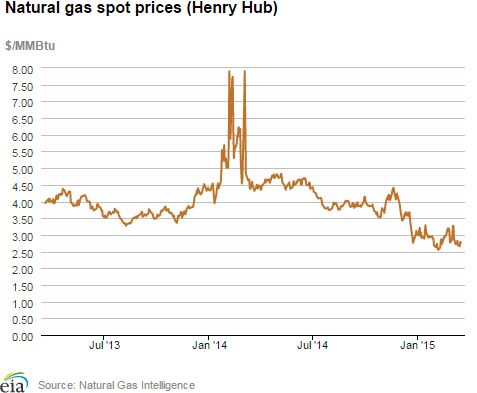
| Spot Prices ($/MMBtu) | Thu, 12-Mar |
Fri, 13-Mar |
Mon, 16-Mar |
Tue, 17-Mar |
Wed, 18-Mar |
|---|---|---|---|---|---|
| Henry Hub |
2.82 |
2.69 |
2.66 |
2.79 |
2.77 |
| New York |
2.80 |
2.52 |
2.65 |
2.85 |
2.83 |
| Chicago |
2.78 |
2.61 |
2.65 |
2.80 |
2.76 |
| Cal. Comp. Avg,* |
2.69 |
2.56 |
2.59 |
2.69 |
2.69 |
| Futures ($/MMBtu) | |||||
| April contract |
2.734 |
2.727 |
2.716 |
2.855 |
2.920 |
| May contract |
2.765 |
2.756 |
2.739 |
2.872 |
2.936 |
| *Avg. of NGI's reported prices for: Malin, PG&E citygate, and Southern California Border Avg. | |||||
| Source: NGI's Daily Gas Price Index | |||||
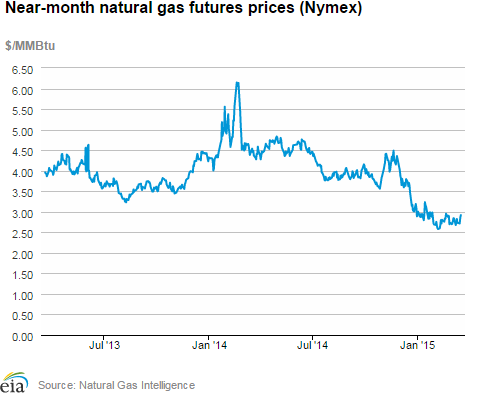
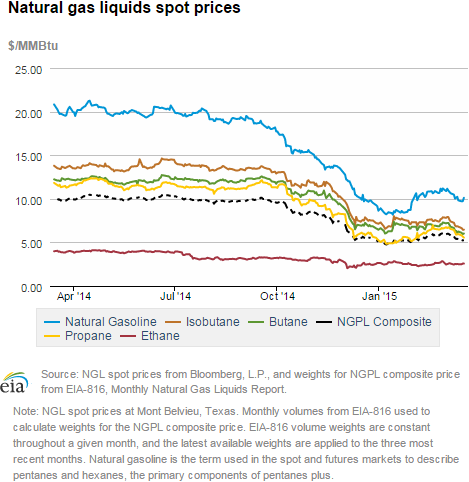
| U.S. natural gas supply - Gas Week: (3/11/15 - 3/18/15) | ||
|---|---|---|
Percent change for week compared with: |
||
last year |
last week |
|
| Gross production | 8.78%
|
0.84%
|
| Dry production | 8.70%
|
0.84%
|
| Canadian imports | 11.05%
|
-1.35%
|
| West (net) | 39.44%
|
1.35%
|
| Midwest (net) | -13.36%
|
22.45%
|
| Northeast (net) | -14.16%
|
-26.67%
|
| LNG imports | 23.59%
|
-42.12%
|
| Total supply | 8.89%
|
0.52%
|
| Source: BENTEK Energy LLC | ||
| U.S. consumption - Gas Week: (3/11/15 - 3/18/15) | ||
|---|---|---|
Percent change for week compared with: |
||
last year |
last week |
|
| U.S. consumption | -10.9%
|
-16.9%
|
| Power | 22.4%
|
-4.4%
|
| Industrial | -5.6%
|
-4.7%
|
| Residential/commercial | -29.5%
|
-31.1%
|
| Total demand | -10.3%
|
-16.8%
|
| Source: BENTEK Energy LLC | ||
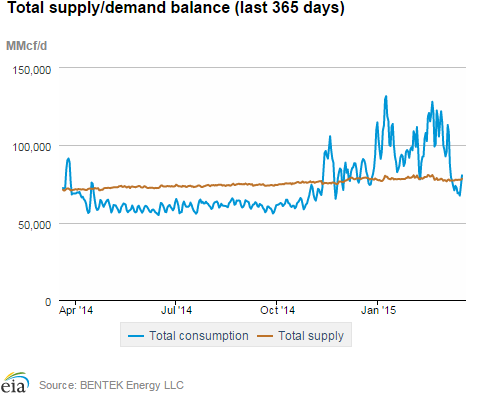
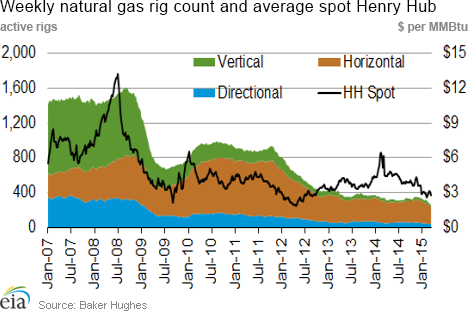
| Rigs | |||
|---|---|---|---|
Fri, March 13, 2015 |
Change from |
||
last week |
last year |
||
| Oil rigs | 866 |
-6.07% |
-40.73% |
| Natural gas rigs | 257 |
-4.10% |
-25.29% |
| Miscellaneous | 2 |
0.00% |
-50.00% |
| Rig numbers by type | |||
|---|---|---|---|
Fri, March 13, 2015 |
Change from |
||
last week |
last year |
||
| Vertical | 166 |
-6.21% |
-57.76% |
| Horizontal | 849 |
-5.14% |
-29.95% |
| Directional | 110 |
-8.33% |
-46.08% |
| Source: Baker Hughes Inc. | |||
| Working gas in underground storage | ||||
|---|---|---|---|---|
Stocks billion cubic feet (bcf) |
||||
| Region | 2015-03-13 |
2015-03-06 |
change |
|
| East | 581 |
618 |
-37 |
|
| West | 338 |
339 |
-1 |
|
| Producing | 548 |
555 |
-7 |
|
| Total | 1,467 |
1,512 |
-45 |
|
| Source: U.S. Energy Information Administration | ||||
| Working gas in underground storage | |||||
|---|---|---|---|---|---|
Historical comparisons |
|||||
Year ago (3/13/14) |
5-year average (2010-2014) |
||||
| Region | Stocks (Bcf) |
% change |
Stocks (Bcf) |
% change |
|
| East | 400 |
45.3 |
742 |
-21.7 |
|
| West | 167 |
102.4 |
271 |
24.7 |
|
| Producing | 393 |
39.4 |
679 |
-19.3 |
|
| Total | 960 |
52.8 |
1,692 |
-13.3 |
|
| Source: U.S. Energy Information Administration | |||||
| Temperature -- heating & cooling degree days (week ending Mar 12) | ||||||||
|---|---|---|---|---|---|---|---|---|
HDD deviation from: |
CDD deviation from: |
|||||||
| Region | HDD Current |
normal |
last year |
CDD Current |
normal |
last year |
||
| New England | 247
|
31
|
16
|
0
|
0
|
0
|
||
| Middle Atlantic | 225
|
23
|
22
|
0
|
0
|
0
|
||
| E N Central | 221
|
8
|
-3
|
0
|
0
|
0
|
||
| W N Central | 161
|
-52
|
-42
|
0
|
-1
|
0
|
||
| South Atlantic | 124
|
2
|
10
|
17
|
7
|
9
|
||
| E S Central | 131
|
14
|
26
|
0
|
-4
|
0
|
||
| W S Central | 101
|
28
|
16
|
1
|
-8
|
-2
|
||
| Mountain | 129
|
-38
|
1
|
3
|
2
|
1
|
||
| Pacific | 43
|
-50
|
-6
|
0
|
-1
|
0
|
||
| United States | 154
|
-6
|
2
|
3
|
-1
|
2
|
||
|
Note: HDD = heating degree-day; CDD = cooling degree-day Source: National Oceanic and Atmospheric Administration | ||||||||
Average temperature (°F)
7-Day Mean ending Mar 12, 2015
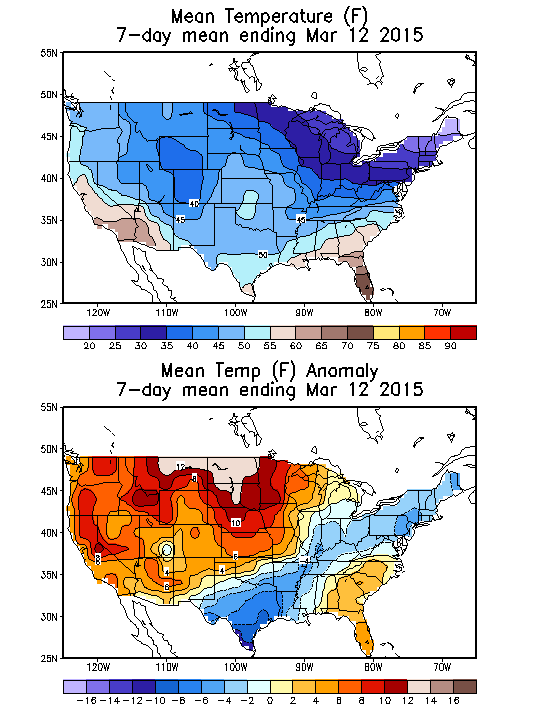
Source: NOAA/National Weather Service
Deviation between average and normal (°F)
7-Day Mean ending Mar 12, 2015

Source: NOAA/National Weather Service

